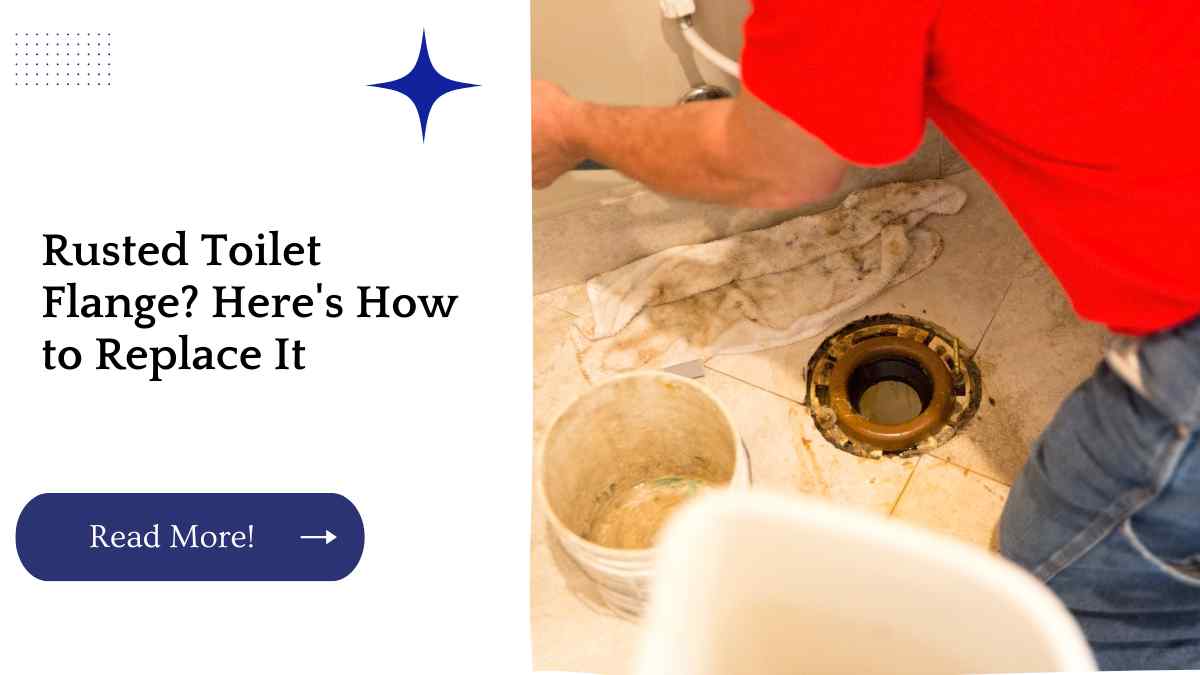Toilet flanges play a critical role in the functionality of a toilet by creating a secure connection between the toilet and the drainpipe. However, over time, the flange can become rusted or corroded, causing leaks and other issues. In this article, we will discuss how to replace a rusted toilet flange, step-by-step.
| Key Takeaways |
|---|
| A rusted toilet flange can cause leaks and other issues, making it necessary to replace it. |
| To replace a rusted flange, you will need a few basic tools and materials, including a new flange, wax ring, and bolts. |
| The process of replacing a rusted flange involves removing the old flange, preparing for a new one, installing the new flange, reattaching the toilet, and testing for leaks. |
| Common issues that may arise during the process of replacing a rusted flange include a new flange that is too high or low, a wobbly toilet, or stripped bolts. |
| To avoid further issues, it’s important to regularly inspect your toilet flange and replace it as needed. |
What is a Toilet Flange?
A toilet flange is a circular pipe fitting that attaches to the toilet’s drain pipe and provides a secure connection between the toilet and the sewer or septic system. It is typically made of PVC, ABS, or cast iron and is installed in the floor to anchor the toilet and create a watertight seal.
When installing a toilet flange on a tiled floor, it’s important to consider the height of the flange. Installing the flange too high can lead to leaks and damage to the subfloor. Check out our guide on toilet flange on top of tile to learn how to install a flange properly and prevent damage to your bathroom.
Signs of a Rusted Toilet Flange
A rusted toilet flange can cause a variety of issues, including leaks, foul odors, and instability of the toilet. Some of the signs that you may have a rusted toilet flange include:
- Visible rust or corrosion around the base of the toilet
- A loose or wobbly toilet
- A toilet that rocks back and forth
- Water leaking from the base of the toilet
- A foul odor coming from the toilet area
Tools and Materials Needed for Flange Replacement
To replace a rusted toilet flange, you will need the following tools and materials:
- Adjustable wrench or pliers
- Screwdriver
- Putty knife
- Hacksaw or reciprocating saw
- New toilet flange
- Wax ring
- Bolts and nuts
Removing the Old Flange
Before you can install a new flange, you will need to remove the old, rusted flange. Here are the steps to follow:
- Turn off the water supply to the toilet and flush it to drain the tank and bowl.
- Use an adjustable wrench or pliers to disconnect the water supply line from the bottom of the tank.
- Use a putty knife to remove the caulking or sealant around the base of the toilet.
- Use a screwdriver to remove the screws or bolts that attach the toilet to the flange.
- Lift the toilet straight up and place it aside on a towel or cardboard to prevent damage.
- Use a hacksaw or reciprocating saw to cut off the old flange, making sure to cut as close to the floor as possible.
- Remove any remaining pieces of the old flange and clean the area around the drainpipe.
Choosing the right drainage pipe for your driveway can be tricky, as there are many factors to consider, such as soil type, traffic volume, and climate. Our guide on finding the right drainage pipe provides helpful tips on choosing the best pipe for your driveway, ensuring proper drainage and preventing costly repairs.
Preparing for a New Flange
Once you have removed the old flange, it’s time to prepare for the installation of a new one. Follow these steps:
- Inspect the drainpipe for any damage or corrosion. If there is any damage, repair it before installing the new flange.
- Clean the area around the drainpipe thoroughly.
- Check the size and type of the existing drainpipe to ensure that the new flange is the correct size and type.
- Install a new wax ring onto the new flange.
Installing a New Flange
Now it’s time to install the new flange. Follow these steps:
- Align the new flange over the drainpipe, making sure that it is level and centered.
- Insert the new bolts into the flange slots.
- Tighten the bolts with a wrench, but be careful not to over-tighten them as this can crack the toilet bowl.
- Apply a small amount of plumber’s putty or silicone sealant around the base of the new flange to create a watertight seal.
- Allow the sealant to dry for the recommended amount of time before proceeding.
Reattaching the Toilet
Now it’s time to reattach the toilet to the new flange. Follow these steps:
- Lift the toilet straight up and lower it onto the new flange, making sure that the bolts protrude through the holes in the base of the toilet.
- Apply gentle pressure to the toilet, pressing it down onto the wax ring and new flange.
- Tighten the nuts onto the bolts with a wrench, being careful not to over-tighten them.
- Reconnect the water supply line to the bottom of the tank.
- Turn on the water supply and check for any leaks.
PEX fittings and polybutylene pipes are popular choices for plumbing projects, but it’s essential to understand their pros and cons before choosing between them. Our guide on PEX fittings and polybutylene pipes provides valuable information on these materials, allowing you to make an informed decision for your plumbing project.
Testing for Leaks
To test for leaks, flush the toilet several times and check for any signs of water leaking from the base of the toilet or around the new flange. If there are no leaks, congratulations – you have successfully replaced your rusted toilet flange!
Troubleshooting Common Issues
Sometimes, issues can arise during the process of replacing a rusted toilet flange. Here are some common issues and how to troubleshoot them:
The New Flange is Too High or Low
If the new flange is too high or low, you may need to use an extender or spacer to raise or lower the toilet. These can be purchased at a hardware store.
The Toilet is Wobbly
If the toilet is wobbly after reattaching it to the new flange, check to make sure that the bolts are tightened evenly and that the toilet is level. You may need to adjust the bolts or use shims to level the toilet.
The Bolts are Stripped
If the bolts are stripped, you will need to remove them and replace them with new ones. You can purchase replacement bolts at a hardware store.
No cold water in your shower can be frustrating, especially in the winter months. There are several possible causes for this issue, including a malfunctioning shower valve, a broken diverter, or a clogged showerhead. Check out our guide on solving the mystery of no cold water in your shower to troubleshoot common causes and restore the flow of cold water to your shower.
Tips and Precautions to Consider
When replacing a rusted toilet flange, there are a few tips and precautions to keep in mind to ensure a successful replacement:
- Always turn off the water supply and disconnect the water supply line before removing the toilet.
- Use caution when using a hacksaw or reciprocating saw to cut off the old flange, as you do not want to damage the drainpipe or the floor.
- Make sure to choose the correct size and type of new flange to ensure a proper fit.
- Do not over-tighten the bolts when attaching the toilet to the new flange, as this can crack the toilet bowl.
Further Reading
If you’re interested in learning more about replacing a rusted toilet flange, check out these helpful resources:
How to Replace a Rusted Toilet Flange: This article provides step-by-step instructions with helpful images to guide you through the process of replacing a rusted toilet flange.
How to Replace a Toilet Flange: This Home Depot guide provides a comprehensive overview of replacing a toilet flange, including tips and precautions to keep in mind.
How to Repair a Toilet Flange: This blog post from Oatey provides helpful tips and advice for repairing a damaged or corroded toilet flange.
Low water pressure in your shower can be a frustrating and uncomfortable experience. Fortunately, there are several simple fixes to improve your shower pressure, such as cleaning your showerhead, checking your valve, and adjusting your water pressure regulator. Visit our guide on boosting your shower pressure to learn more about these solutions and enjoy a refreshing shower experience.
Frequently Asked Questions
What Causes Toilet Flanges to Rust?
Toilet flanges can rust over time due to exposure to moisture and other environmental factors. This can cause corrosion and weakening of the flange, leading to leaks and other issues.
Can I Replace a Toilet Flange Myself?
Yes, you can replace a toilet flange yourself, but it does require some basic plumbing knowledge and tools. If you are not comfortable with plumbing or are unsure of your ability to complete the task, it may be best to hire a professional plumber.
How Long Does It Take to Replace a Toilet Flange?
The time it takes to replace a toilet flange depends on several factors, including the condition of the existing flange and the level of difficulty in removing it. In general, the process can take anywhere from 1-3 hours.
How Much Does It Cost to Replace a Toilet Flange?
The cost of replacing a toilet flange can vary depending on several factors, such as the type of flange and the cost of labor. On average, the cost can range from $150-$300.
How Often Should I Replace My Toilet Flange?
Toilet flanges can last for many years if properly maintained. However, if you notice any signs of rust, corrosion, or leaks, it may be time to replace the flange. It is recommended to inspect your toilet flange regularly and replace it as needed.
Conclusion
Replacing a rusted toilet flange may seem daunting, but with the right tools and knowledge, it can be done successfully. By following the steps outlined in this article, you can ensure a proper and watertight connection between your toilet and drainpipe, eliminating leaks and other issues. Remember to regularly inspect your toilet flange to avoid future issues and to call a professional if you are not comfortable with plumbing tasks.

Hellen James is the author of the blog and a licensed plumber with over 15 years of experience. She shares her knowledge and experience in plumbing and drainage through insightful and informative articles

